George C. Scott's gritty voice still rings, barking orders at troops he commanded to face down the enemy in foreign lands, as he embodied "Old Blood and Guts" (their blood, his guts) in the movie Patton.
The powerful performance about the life of U.S. Major General George S. Patton, notably during World War II, made the battle scenes come alive when I visited the North Africa American Cemetery and Memorial in Sidi Bou Said on the outskirts of Tunis and saw them depicted on murals and across a grassy carpet of graves.
Patton's North Africa wartime operations and other military deployments are beautifully illustrated in a series of intricate and colorful mosaics at the site's Open-Air Map Room.
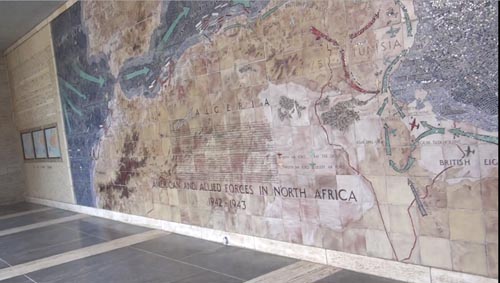 American and Allied Forces in North Africa deployments depicted on mosaic in the Open-Air Map Room (Abu-Fadil)
American and Allied Forces in North Africa deployments depicted on mosaic in the Open-Air Map Room (Abu-Fadil)
By November, U.S. and British troops, as part of naval task forces, landed in Casablanca, Morocco (also made famous by a Hollywood movie), as well as in Oran and Algiers, Algeria.
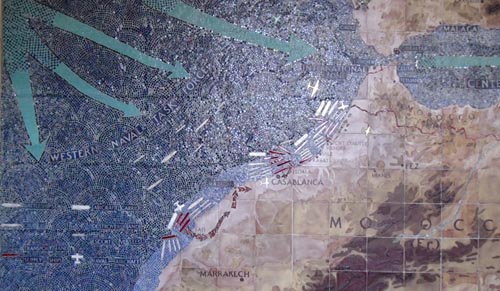 Mosaic of U.S. and British forces landing in North Africa (Abu-Fadil)
Mosaic of U.S. and British forces landing in North Africa (Abu-Fadil)
From December 1942 to February 1943, the tables turned briefly when inclement weather coupled with more robust German forces and air superiority stalled Allied advances into Tunisia.
But by early February, the British Eighth Army forced Germany's powerful Afrika Corps into southeastern Tunisia at the Mareth Line.
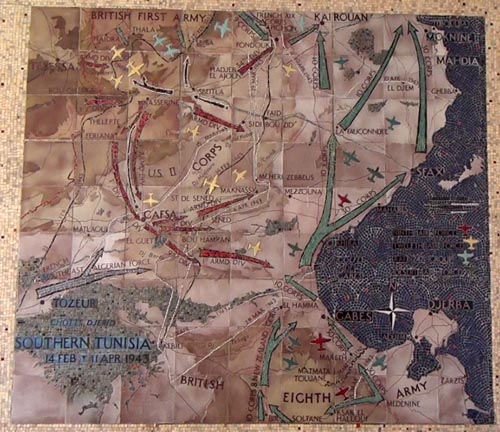 British Eighth Army pushes Afrika Corps into southeastern Tunisia (Abu-Fadil)
British Eighth Army pushes Afrika Corps into southeastern Tunisia (Abu-Fadil)
For five days during the battle of Kasserine Pass, German troops gained the high ground from U.S. units, but were eventually repelled in heavy fighting, causing the Germans to withdraw towards the capital, Tunis.
It wasn't until May 13, 1943 when Axis forces surrendered, but by then, countless lives had been lost.
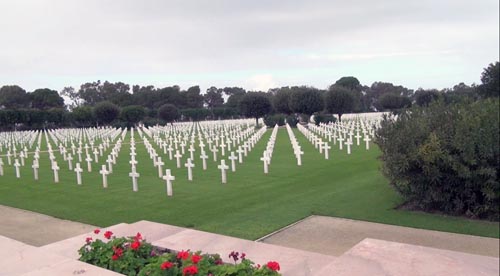 North Africa American Cemetery and Memorial headstones (Abu-Fadil)
North Africa American Cemetery and Memorial headstones (Abu-Fadil)
For this former Washingtonian and history buff, it was like visiting a smaller version of Arlington National Cemetery.
The brisk wind and pelting cold winter rain from an overcast sky added to the sense of grief at how many soldiers had died and were buried away from home -- some identified, others unknown or missing in action.
The 2,833 headstones in six neatly divided plots are arranged in lines, "harmonizing with the rectangular layout of the cemetery and memorial," according to a brochure of the place.
Four fountains and pools with surrounding vegetation bracket the center square of headstones and serve as oases against the hot climate in summer.
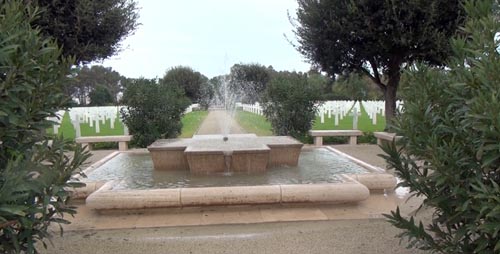 Cooling water oases amidst the graves (Abu-Fadil)
Cooling water oases amidst the graves (Abu-Fadil)
I had seen the cemetery in 1988, accidentally discovering its existence while on a trip to interview the late PLO leader Yasser Arafat, after he'd been chased out of Lebanon and set up his headquarters in Tunisia, and had wanted to return to write about it.
A recent post-conference stay in Tunisia allowed me to revisit it and remember how much the peaceful setting and painstakingly maintained area were a tribute to those fallen warriors.
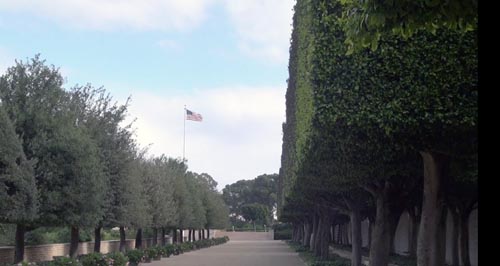 U.S. flag flutters in Tunisia's winter wind at the North Africa American Cemetery and Memorial (Abu-Fadil)
U.S. flag flutters in Tunisia's winter wind at the North Africa American Cemetery and Memorial (Abu-Fadil)
But this time I needed permission from the American Battle Monuments Commission's Paris office to film or photograph the facility (since it was for a story and not for personal use), which a staffer on-site arranged by faxing my written request to those in charge.
It seemed there were new regulations since my last trip, but the approval came and I once again enjoyed the visit to this off-the-tourist-map 27-acre site.
The facility is administered by the Arlington, Virginia-based American Battle Monuments Commission, which operates and maintains 24 American cemeteries and 25 memorials, monuments and markers in 15 countries.
The Commission works to fulfill the vision of its first chairman, General of the Armies John J. Pershing, who had commanded the American Expeditionary Forces during World War I.
"Honor to them that trod the path of honor," reads an inscription on the pedestal of a statue called "Honor," at the beginning of a tree-lined walk to the battle murals.
 "Honor" figure bestows a laurel wreath on fallen soldiers (Abu-Fadil)
"Honor" figure bestows a laurel wreath on fallen soldiers (Abu-Fadil)
On the left side of the walk is a 364-foot long display of names and details of 3,724 missing in action (land, sea and air) in North Africa carved into a series of tablets.
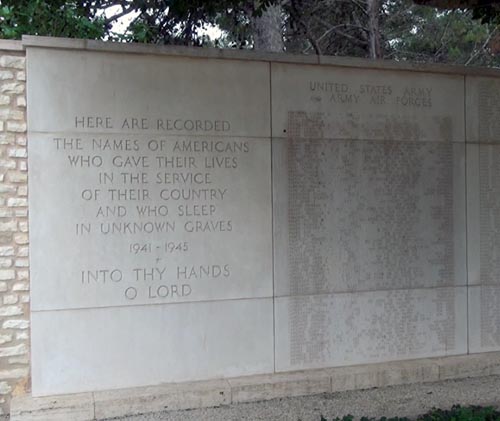 Tablets bearing names of MIAs in North Africa during WWII (Abu-Fadil)
Tablets bearing names of MIAs in North Africa during WWII (Abu-Fadil)
Just before the mosaic murals, rests the chapel with a handful of pews, the U.S. flag, Christian and Jewish chapel flags, as well as flags of the combat arms.
Carved on the wall under them are the words: "Almighty God Receive These Thy Heroic Servants Into Thy Kingdom."
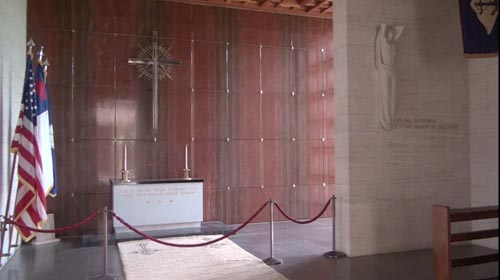 North Africa American Cemetery & Memorial Chapel (Abu-Fadil)
North Africa American Cemetery & Memorial Chapel (Abu-Fadil)
A wall outside the chapel has an inscription in English, Arabic and French that reads: "1941-1945 In proud remembrance of the achievement of her sons and in humble tribute to their sacrifices this memorial has been erected by the United States of America."
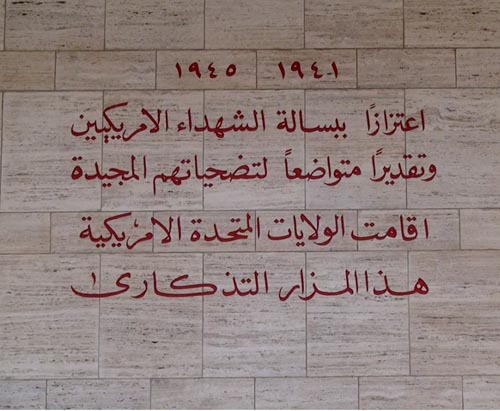 Arabic inscription paying tribute to American soldiers' sacrifices (Abu-Fadil)
Arabic inscription paying tribute to American soldiers' sacrifices (Abu-Fadil)
As I headed back to the main entrance a slow knell sounded on the hour.
I could just imagine a lone trumpeter playing taps and a Marine folding the Stars and Stripes into a triangle and handing it to a fallen soldier's loved ones.
